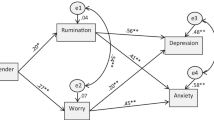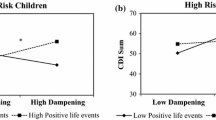Abstract
Worry and rumination both refer to unproductive, repetitive thought processes. Few studies have addressed the relationship between these two constructs, with most researchers exclusively relating rumination to depression and worry to anxiety. The present study examined relationships between self-reported rumination as assessed by the Children's Response Style Scale (CRSS), worry as measured by the Penn State Worry Questionnaire for Children (PSWQ-C), and anxiety and depression symptoms as indexed by respectively the Screen for Child Anxiety Related Emotional Disorders (SCARED) and the Children's Depression Inventory (CDI) in a sample of 337 nonclinical adolescents aged 12–17 years. Results showed that rumination and worry were substantially correlated. Further, a factor analysis showed that both constructs were nevertheless distinct as rumination and worry items loaded on separate factors. Interestingly, both rumination and worry correlated more substantially with anxiety symptoms than with depression symptoms. Finally, worry emerged as a unique predictor of anxiety symptoms, even when controlling for rumination. In contrast, when controlling for worry, rumination no longer accounted for a significant proportion of the variance in depression symptoms.
Similar content being viewed by others
REFERENCES
Abela, J. R. Z., Brozina, K., & Haigh, E. P. (2002). An examination of the response styles theory of depression in third-and seventh-grade children: A short-term longitudinal study. Journal of Abnormal Child Psychology, 30, 515–527.
American Psychiatric Association. (1994). Diagnostic and statistical manual of mental disorders, fourth edition (DSM-IV). Washington, DC: American Psychiatric Association.
Bernstein, G. A., Borchardt, C. M., & Perwien, A. R. (1996). Anxiety disorders in children and adolescents: Areview of the past 10 years. Journal of the American Academy of Child and Adolescent Psychiatry, 35, 1110–1119.
Birmaher, B., Brent, D., Chiappetta, L., Bridge, J., Monga, S., & Baugher, M. (1999). Psychometric properties of the Screen for Child Anxiety Related Emotional Disorders (SCARED): A replication study. Journal of the American Academy of Child and Adolescent Psychiatry, 38, 1230–1236.
Birmaher, B., Khetarpal, S., Brent, D., Cully, M., Balach, L., Kaufman, J., et al. (1997). The Screen for Child Anxiety Related Emotional Disorders (SCARED): Scale construction and psychometric characteristics. Journal of the American Academy of Child and Adolescent Psychiatry, 36, 545–553.
Birmaher, B., Ryan, N. D., Williamson, D. E., Brent, D. A., Kaufman, J., Dahl, R. E., et al. (1996). Childhood and adolescent depression: A review of the past 10 years. Part I. Journal of the American Academy of Child and Adolescent Psychiatry, 35, 1427–1439.
Blagden, J. C., & Craske, M. G. (1996). Effects of active and passive rumination and distraction: A pilot replication with anxious mood. Journal of Anxiety Disorders, 10, 243–252.
Borkovec, T. D., Robinson, E., Pruzinsky, T., & DePree, J. A. (1983). Preliminary exploration of worry: Some characteristics and processes. Behaviour Research and Therapy, 21, 9–16.
Broderick, P. C. (1998). Early adolescent gender differences in the use of ruminative and distracting coping styles. Journal of Early Adolescence, 18, 173–191.
Butler, L. D., & Nolen-Hoeksema, S. (1994). Gender differences in responses to depressed mood in a college sample. Sex Roles, 30, 331–346.
Campbell, D. T., & Fiske, D. W. (1959). Convergent and discriminant validation by the multitrait-multimethod matrix. Psychological Bulletin, 56, 81–105.
Chorpita, B. F., Tracey, S. A., Brown, T. A., Collica, T. J., & Barlow, D. H. (1997). Assessment of worry in children and adolescents: An adaptation of the Penn State Worry Questionnaire. Behaviour Research and Therapy, 35, 569–581.
Daleiden, E. L., & Vasey, M. W. (1997). An information-processing perspective on childhood anxiety. Clinical Psychology Review, 17, 407–429.
Flavell, J. H., Miller, P. H., & Miller, S. A. (1993). Cognitive development. Upper Saddle River, NJ: Prentice-Hall.
Fleming, J. E., & Offord, D. R. (1990). Epidemiology of childhood depressive disorders: Acritical review. Journal of the American Academy of Child and Adolescent Psychiatry, 29, 571–580.
Fresco, D. M., Frankel, A. N., Mennin, D. S., Turk, C. L., & Heimberg, R. G. (2002). Distinct and overlapping features of rumination and worry: The relationship of cognitive production to negative affective states. Cognitive Therapy and Research, 26, 179–188.
Gladstone, T. R. G., & Kaslow, N. J. (1995). Depression and attributions in children and adolescents: A meta-analytic review. Journal of Abnormal Child Psychology, 23, 597–606.
Joiner, T. E., & Wagner, K. D. (1995). Attributional style and depression in children and adolescents: A meta-analytic review. Clinical Psychology Review, 15, 777–798.
Just, N., & Alloy, L. B. (1997). The response styles theory of depression: Tests and an extension of the theory. Journal of Abnormal Psychology, 106, 221–229.
Kendall, P. C., Cantwell, D. P., & Kazdin, A. E. (1989). Depression in children and adolescents: Assessment issues and recommendations. Cognitive Therapy and Research, 13, 109–146.
King, N. J., Ollendick, T. H., & Gullone, E. (1991). Negative affectivity in children and adolescents: Relations between anxiety and depression. Clinical Psychology Review, 11, 441–459.
Kovacs, M. (1981). Rating scales to assess depression in school-aged children. Acta Paedopsychiatrica, 46, 305–315.
Lewinsohn, P. M., Clarke, G. N., Seeley, J. R., & Rohde, P. (1994). Major depression in community adolescents: Age at onset, episode duration, and time to recurrence. Journal of the American Academy of Child and Adolescent Psychiatry, 33, 809–818.
Lewinsohn, P. M., Duncan, E. M., Stanton, A. K., & Hautziner, M. (1986). Age at onset for first unipolar depression. Journal of Abnormal Psychology, 95, 378–383.
Lewinsohn, P. M., Hops, H., Roberts, R. E., Seeley, J. R., & Andrews, J. A. (1993). Adolescent psychopathology: I. Prevalence and incidence of depression and other DSM-III-R disorders in high school students. Journal of Abnormal Psychology, 102, 133–144.
Lyubomirsky, S., & Nolen-Hoeksema, S. (1993). Self-perpetuating properties of dysphoric rumination. Journal of Personality and Social Psychology, 65, 339–349.
Meng, X. L., Rosenthal, R., & Rubin, D. B. (1992). Comparing correlated correlation coefficients. Psychological Bulletin, 111, 172–175.
Muris, P., Dreessen, L., Bögels, S. M., Weckx, M., & Van Melick, M. (2004). A questionnaire for screening a broad range of DSM-defined anxiety disorder symptoms in clinically referred children and adolescents. Journal of Child Psychology and Psychiatry, 45, 813–820.
Muris, P., Meesters, C., & Gobel, M. (2001). Reliability, validity, and normative data of the Penn State Worry Questionnaire in 8-to 12-year old children. Journal of Behavior Therapy and Experimental Psychiatry, 32, 63–72.
Muris, P., Merckelbach, H., Ollendick, T. H., King, N. J., & Bogie, N. (2002). Three traditional and three new childhood anxiety questionnaires: Their reliability and validity in a normal adolescent sample. Behaviour Research and Therapy, 40, 753–772.
Muris, P., Schmidt, H., Lambrichs, R., & Meesters, C. (2001). Protective and vulnerability factors of depression in normal adolescents. Behaviour Research and Therapy, 39, 555–565.
Nolan, S. A., Roberts, J. E., & Gotlib, I. H. (1998). Neuroticism and ruminative response style as predictors of change in depressive symptomatology. Cognitive Therapy and Research, 22, 445–455.
Nolen-Hoeksema, S. (1987). Sex differences in unipolar depression: Evidence and theory. Psychological Bulletin, 101, 259–282.
Nolen-Hoeksema, S. (1991). Responses to depression and their effects on the duration of depressive episodes. Journal of Abnormal Psychology, 100, 569–582.
Nolen-Hoeksema, S. (1998). Ruminative coping with depression. In J. Heckhausen & C. S. Dweck (Eds.), Motivation and self-regulation across the life span (pp. 237–256). New York: Cambridge University Press.
Nolen-Hoeksema, S. (2000). The role of rumination in depressive disorders and mixed anxiety/depressive symptoms. Journal of Abnormal Psychology, 109, 504–511.
Nolen-Hoeksema, S., & Girgus, J. S. (1994). The emergence of gender differences in depression during adolescence. Psychological Bulletin, 115, 424–443.
Nolen-Hoeksema, S., Girgus, J. S., & Seligman, M. E. P. (1992). Predictors and consequences of childhood depressive symptoms: A 5-year longitudinal study. Journal of Abnormal Psychology, 101, 405–422.
Nolen-Hoeksema, S., Larson, J., & Grayson, C. (1999). Explaining the gender difference in depressive symptoms. Journal of Personality and Social Psychology, 77, 1061–1072.
Nolen-Hoeksema, S., & Morrow, J. (1993). Effects of rumination and distraction on naturally-occurring depressed moods. Cognition and Emotion, 7, 561–570.
Nolen-Hoeksema, S., Morrow, J., & Fredrickson, B. L. (1993). Response styles and the duration of episodes of depressed mood. Journal of Abnormal Psychology, 102, 20–28.
Papageorgiou, C., & Siegle, G. J. (2003). Rumination and depression: Advances in theory and research. Cognitive Therapy and Research, 27, 243–245.
Papageorgiou, C., & Wells, A. (1999). Process and meta-cognitive dimensions of depressive and anxious thoughts and relationships with emotional intensity. Clinical Psychology and Psychotherapy, 6, 156–162.
Robinson, M. S., & Alloy, L. B. (2003). Negative cognitive styles and stress-reactive rumination interact to predict depression: A prospective study. Cognitive Therapy and Research, 27, 275–292.
Saylor, C. F., Finch, A. J., Spirito, A., & Bennett, B. (1984). The Children's Depression Inventory: A systematic evaluation of psychometric properties. Journal of Consulting and Clinical Psychology, 52, 955–967.
Schwartz, J. A. J., & Koenig, L. J. (1996). Response styles and negative affect among adolescents. Cognitive Therapy and Research, 20, 13–36.
Segerstrom, S. C., Tsao, J. C. I., Alden, L. E., & Craske, M. G. (2000). Worry and rumination: Repetitive thought as a concomitant and predictor of negative mood. Cognitive Therapy and Research, 24, 671–688.
Starcevic, V. (1995). Pathological worry in major depression. Behaviour Research and Therapy, 33, 55–56.
Szabó, M., & Lovibond, P. F. (2002). The cognitive content of naturally occurring worry episodes. Cognitive Therapy and Research, 26, 167–177.
Teasdale, J. D. (1983). Negative thinking in depression: Cause, effect, or reciprocal relationship? Advances in Behaviour Research and Therapy, 5, 27–49
Timbremont, B., & Braet, C. (2001). Psychometrische evaluatie van de Nederlandstalige Children's Depression Inventory (Psychometric assessment of the Dutch version of the Children's Depression Inventory). Gedragstherapie, 34, 229–242.
Vickers, K. S., & Vogeltanz-Holm, N. D. (2003). The effects of rumination and distraction tasks on psychophysiological responses and mood in dysphoric and nondysphoric individuals. Cognitive Therapy and Research, 27, 331–348.
Ziegert, D. I., & Kistner, J. A. (2002). Response styles theory: Downward extension to children. Journal of Clinical Child and Adolescent Psychology, 31, 325–334.
Author information
Authors and Affiliations
Rights and permissions
About this article
Cite this article
Muris, P., Roelofs, J., Meesters, C. et al. Rumination and Worry in Nonclinical Adolescents. Cognitive Therapy and Research 28, 539–554 (2004). https://doi.org/10.1023/B:COTR.0000045563.66060.3e
Issue Date:
DOI: https://doi.org/10.1023/B:COTR.0000045563.66060.3e




